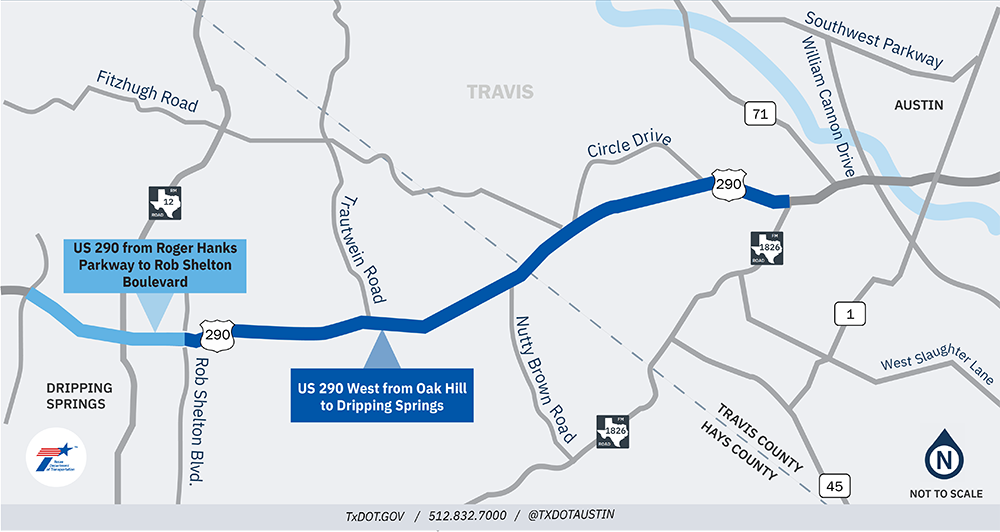US 290 from Oak Hill to Dripping Springs Environmental Study
TxDOT is conducting an environmental study to evaluate long-term safety and mobility solutions along US 290 from RM 1826 in southwest Austin to Rob Shelton Boulevard in Dripping Springs. US 290 is a four-lane undivided roadway with a center-turn lane and signalized intersections.

*Based on public feedback, improvements to US 290 from Roger Hanks Parkway to Rob Shelton Boulevard will likely advance separately. In this area, the four-lane divided highway will be upgraded to a six-lane divided highway with bicycle and pedestrian accommodations.
The purpose of the project is to:
- Improve mobility and safety in the corridor
- Enhance accessibility for residents and businesses
- Improve emergency response times
- Minimize impacts to the community and natural environment
The study will include:
- Engagement with community stakeholders, public agencies and local governments
- Continued analyses of current corridor conditions
- Presentation of the purpose and need for the project
- Evaluation of design options and the No Build (do nothing) alternative
- Evaluation of potential impacts to the community and environment (e.g., water resources, air quality, noise, threatened and endangered species, historical and archeological resources, land use and parkland)
- Recommendation of a design option or No Build alternative
Need for improvements
There is a need to enhance safety, improve mobility and reduce congestion along US 290 in this area. The crash rate is more than 86% higher than the statewide average for rural corridors. One crash occurs about every other day along US 290 in the study area. Existing conditions should be updated to accommodate current and projected traffic volumes and travel patterns.
Improvements were first identified as a need by the Capital Area Metropolitan Planning Organization in 2010 and the need is increasing due to rapid population growth and development occurring along US 290 and the communities around it.
Since 2010, daily traffic increased by up to 50% within the study area, and the number of vehicles travelling along US 290 is expected to increase by 3-5 times over the next 30 years.
Project development process
The US 290 from Oak Hill to Dripping Springs Environmental Study began in 2022. This is the second phase of a multi-step process to determine options for maximizing safety and mobility along the corridor. Stakeholder engagement occurs on an ongoing basis throughout all project development phases:
- Phase 1: Planning and Feasibility Study (completed 2019-2020)
- Phase 2: Environmental Study (We are Here)
- Phase 3: Final design, right-of-way acquisition and utility adjustments
- Phase 4: Construction (unfunded)

Get involved
Information about previous public involvement activities can be accessed below:
- In-person workshop with virtual option - Saturday, June 1, 2024
- Virtual public meeting - Tuesday, Jan. 16, 2024
- In-person public meeting - Tuesday, Jan. 30, 2024
- Public Meetings Summary Report - Oct. 2019